2015 NISSAN TITAN transmission oil
[x] Cancel search: transmission oilPage 363 of 457
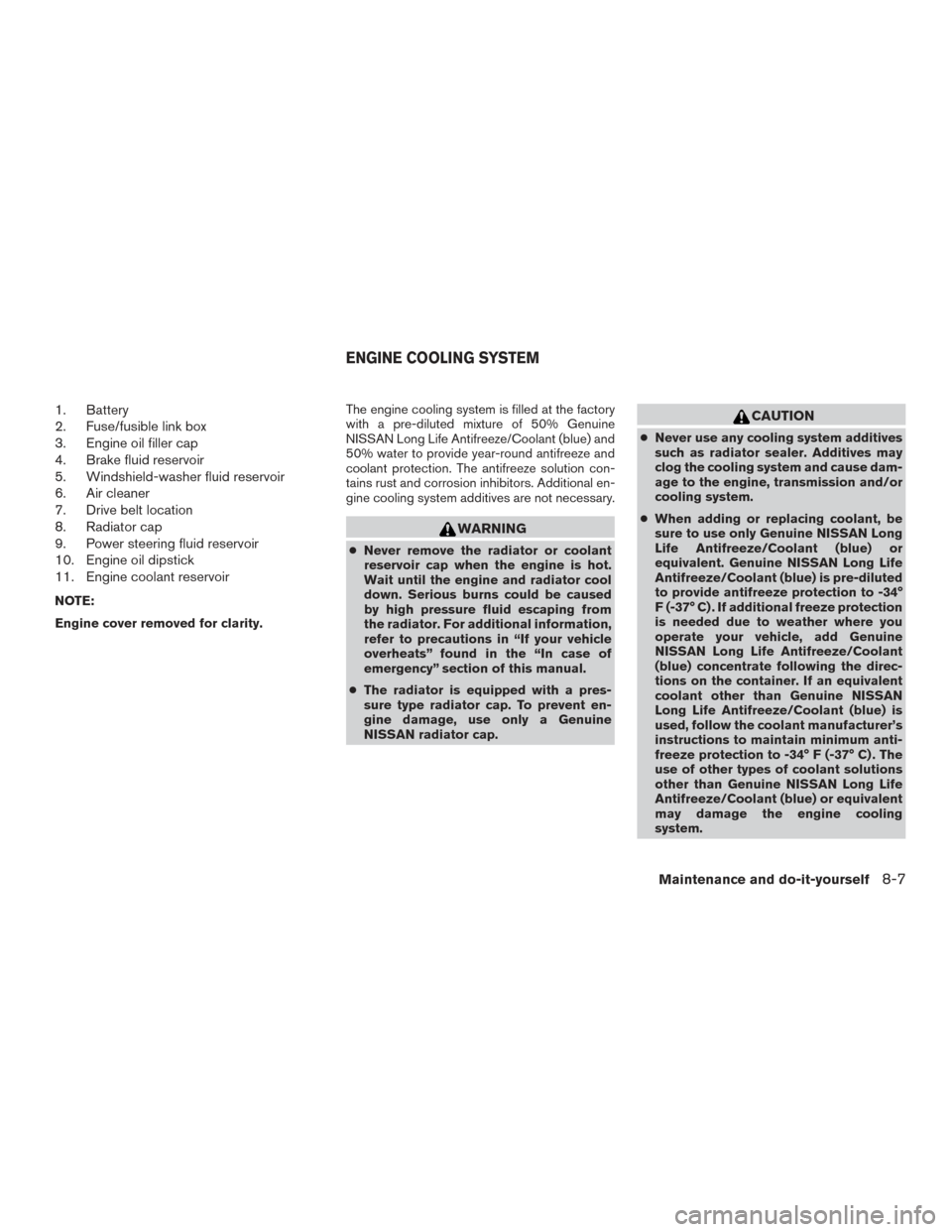
1. Battery
2. Fuse/fusible link box
3. Engine oil filler cap
4. Brake fluid reservoir
5. Windshield-washer fluid reservoir
6. Air cleaner
7. Drive belt location
8. Radiator cap
9. Power steering fluid reservoir
10. Engine oil dipstick
11. Engine coolant reservoir
NOTE:
Engine cover removed for clarity.The engine cooling system is filled at the factory
with a pre-diluted mixture of 50% Genuine
NISSAN Long Life Antifreeze/Coolant (blue) and
50% water to provide year-round antifreeze and
coolant protection. The antifreeze solution con-
tains rust and corrosion inhibitors. Additional en-
gine cooling system additives are not necessary.
WARNING
●
Never remove the radiator or coolant
reservoir cap when the engine is hot.
Wait until the engine and radiator cool
down. Serious burns could be caused
by high pressure fluid escaping from
the radiator. For additional information,
refer to precautions in “If your vehicle
overheats” found in the “In case of
emergency” section of this manual.
● The radiator is equipped with a pres-
sure type radiator cap. To prevent en-
gine damage, use only a Genuine
NISSAN radiator cap.
CAUTION
● Never use any cooling system additives
such as radiator sealer. Additives may
clog the cooling system and cause dam-
age to the engine, transmission and/or
cooling system.
● When adding or replacing coolant, be
sure to use only Genuine NISSAN Long
Life Antifreeze/Coolant (blue) or
equivalent. Genuine NISSAN Long Life
Antifreeze/Coolant (blue) is pre-diluted
to provide antifreeze protection to -34°
F (-37° C) . If additional freeze protection
is needed due to weather where you
operate your vehicle, add Genuine
NISSAN Long Life Antifreeze/Coolant
(blue) concentrate following the direc-
tions on the container. If an equivalent
coolant other than Genuine NISSAN
Long Life Antifreeze/Coolant (blue) is
used, follow the coolant manufacturer’s
instructions to maintain minimum anti-
freeze protection to -34° F (-37° C) . The
use of other types of coolant solutions
other than Genuine NISSAN Long Life
Antifreeze/Coolant (blue) or equivalent
may damage the engine cooling
system.
ENGINE COOLING SYSTEM
Maintenance and do-it-yourself8-7
Page 402 of 457
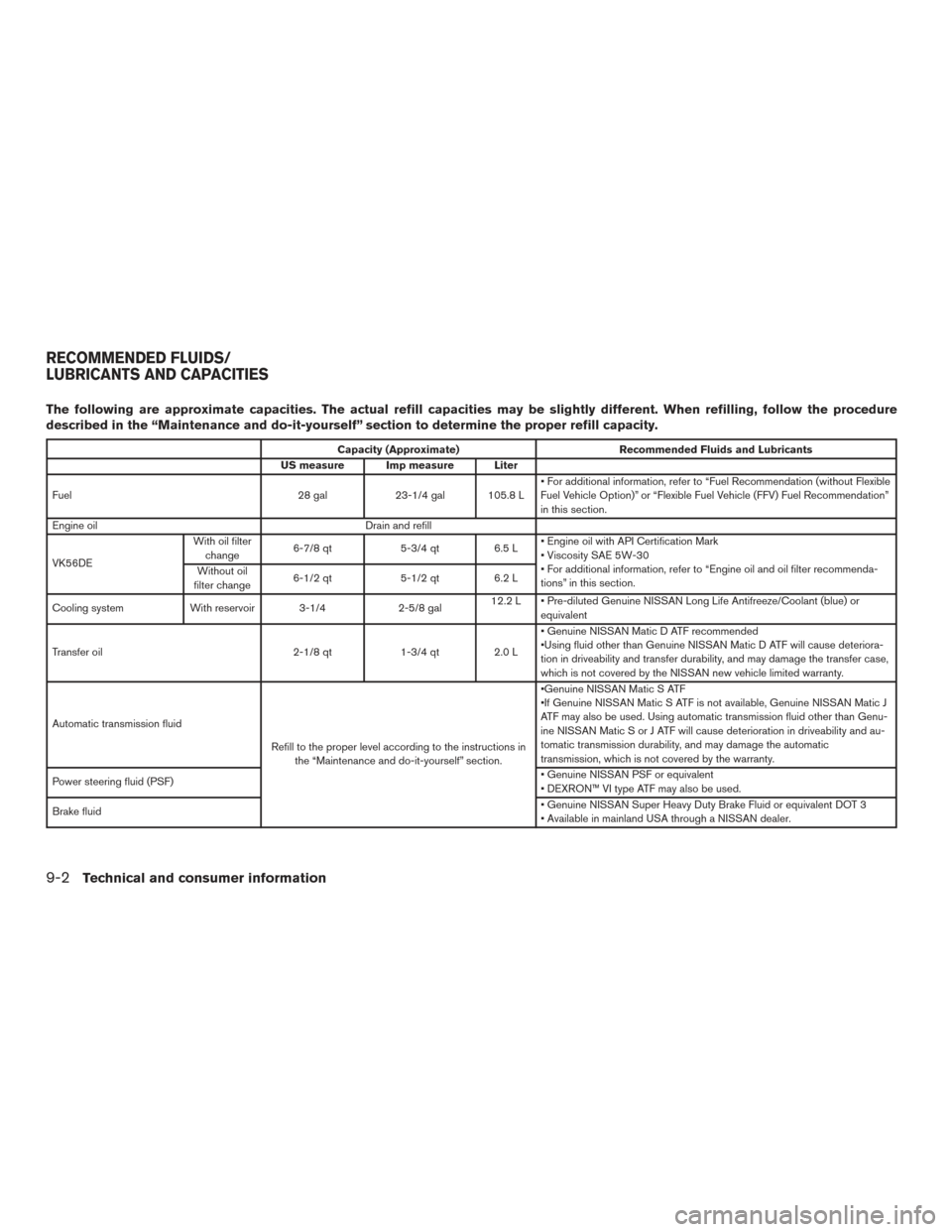
The following are approximate capacities. The actual refill capacities may be slightly different. When refilling, follow the procedure
described in the “Maintenance and do-it-yourself” section to determine the proper refill capacity.
Capacity (Approximate)Recommended Fluids and Lubricants
US measure Imp measure Liter
Fuel 28 gal23-1/4 gal 105.8 L • For additional information, refer to “Fuel Recommendation (without Flexible
Fuel Vehicle Option)” or “Flexible Fuel Vehicle (FFV) Fuel Recommendation”
in this section.
Engine oil Drain and refill
VK56DE With oil filter
change 6-7/8 qt
5-3/4 qt6.5 L• Engine oil with API Certification Mark
• Viscosity SAE 5W-30
• For additional information, refer to “Engine oil and oil filter recommenda-
tions” in this section.
Without oil
filter change 6-1/2 qt
5-1/2 qt6.2 L
Cooling system With reservoir 3-1/4 2-5/8 gal12.2 L • Pre-diluted Genuine NISSAN Long Life Antifreeze/Coolant (blue) or
equivalent
Transfer oil 2-1/8 qt1-3/4 qt2.0 L• Genuine NISSAN Matic D ATF recommended
•Using fluid other than Genuine NISSAN Matic D ATF will cause deteriora-
tion in driveability and transfer durability, and may damage the transfer case,
which is not covered by the NISSAN new vehicle limited warranty.
Automatic transmission fluid Refill to the proper level according to the instructions inthe “Maintenance and do-it-yourself” section. •Genuine NISSAN Matic S ATF
•If Genuine NISSAN Matic S ATF is not available, Genuine NISSAN Matic J
ATF may also be used. Using automatic transmission fluid other than Genu-
ine NISSAN Matic S or J ATF will cause deterioration in driveability and au-
tomatic transmission durability, and may damage the automatic
transmission, which is not covered by the warranty.
Power steering fluid (PSF) • Genuine NISSAN PSF or equivalent
• DEXRON™ VI type ATF may also be used.
Brake fluid • Genuine NISSAN Super Heavy Duty Brake Fluid or equivalent DOT 3
• Available in mainland USA through a NISSAN dealer.
RECOMMENDED FLUIDS/
LUBRICANTS AND CAPACITIES
9-2Technical and consumer information
Page 440 of 457
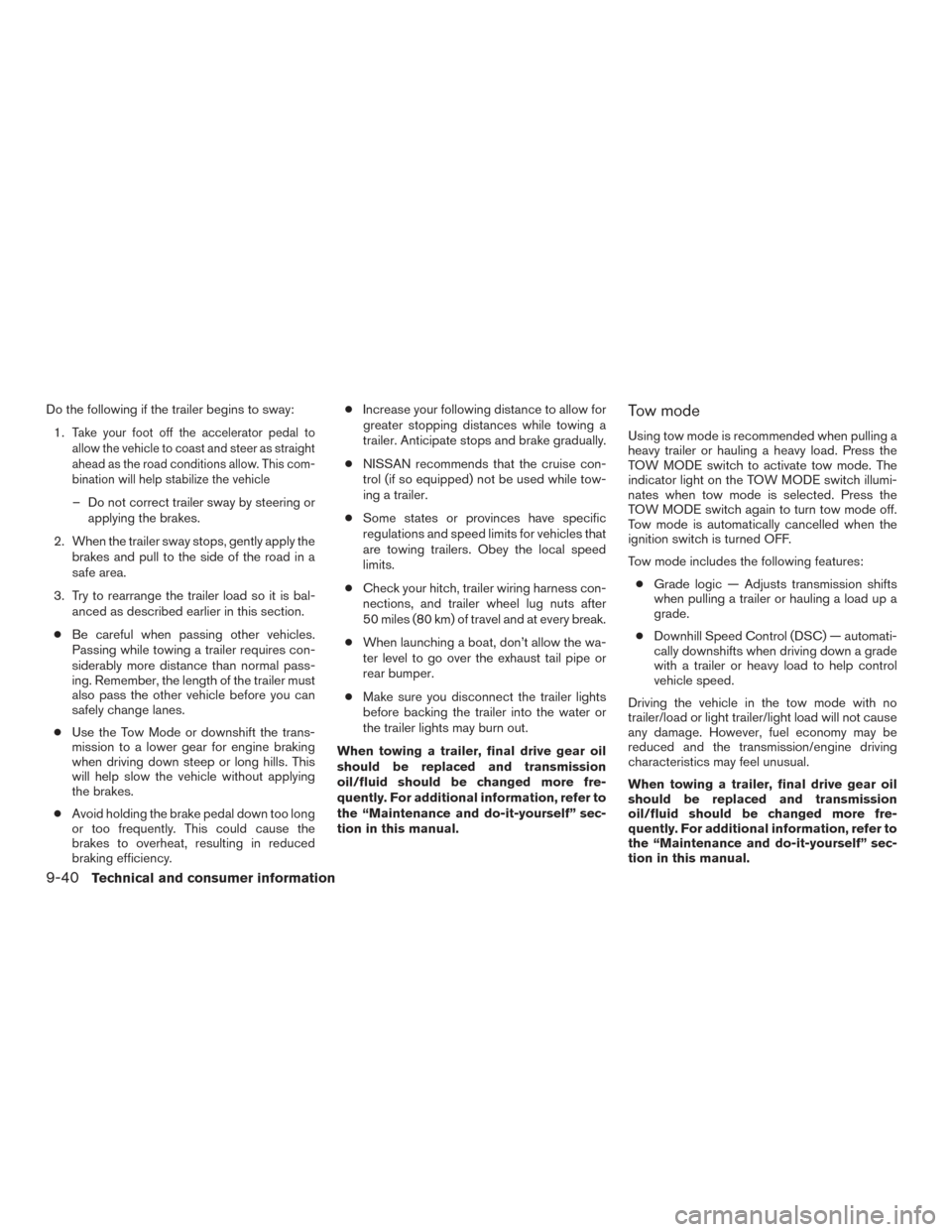
Do the following if the trailer begins to sway:1.
Take your foot off the accelerator pedal to
allow the vehicle to coast and steer as straight
ahead as the road conditions allow. This com-
bination will help stabilize the vehicle
– Do not correct trailer sway by steering or applying the brakes.
2. When the trailer sway stops, gently apply the brakes and pull to the side of the road in a
safe area.
3. Try to rearrange the trailer load so it is bal- anced as described earlier in this section.
● Be careful when passing other vehicles.
Passing while towing a trailer requires con-
siderably more distance than normal pass-
ing. Remember, the length of the trailer must
also pass the other vehicle before you can
safely change lanes.
● Use the Tow Mode or downshift the trans-
mission to a lower gear for engine braking
when driving down steep or long hills. This
will help slow the vehicle without applying
the brakes.
● Avoid holding the brake pedal down too long
or too frequently. This could cause the
brakes to overheat, resulting in reduced
braking efficiency. ●
Increase your following distance to allow for
greater stopping distances while towing a
trailer. Anticipate stops and brake gradually.
● NISSAN recommends that the cruise con-
trol (if so equipped) not be used while tow-
ing a trailer.
● Some states or provinces have specific
regulations and speed limits for vehicles that
are towing trailers. Obey the local speed
limits.
● Check your hitch, trailer wiring harness con-
nections, and trailer wheel lug nuts after
50 miles (80 km) of travel and at every break.
● When launching a boat, don’t allow the wa-
ter level to go over the exhaust tail pipe or
rear bumper.
● Make sure you disconnect the trailer lights
before backing the trailer into the water or
the trailer lights may burn out.
When towing a trailer, final drive gear oil
should be replaced and transmission
oil/fluid should be changed more fre-
quently. For additional information, refer to
the “Maintenance and do-it-yourself” sec-
tion in this manual.
Tow mode
Using tow mode is recommended when pulling a
heavy trailer or hauling a heavy load. Press the
TOW MODE switch to activate tow mode. The
indicator light on the TOW MODE switch illumi-
nates when tow mode is selected. Press the
TOW MODE switch again to turn tow mode off.
Tow mode is automatically cancelled when the
ignition switch is turned OFF.
Tow mode includes the following features: ● Grade logic — Adjusts transmission shifts
when pulling a trailer or hauling a load up a
grade.
● Downhill Speed Control (DSC) — automati-
cally downshifts when driving down a grade
with a trailer or heavy load to help control
vehicle speed.
Driving the vehicle in the tow mode with no
trailer/load or light trailer/light load will not cause
any damage. However, fuel economy may be
reduced and the transmission/engine driving
characteristics may feel unusual.
When towing a trailer, final drive gear oil
should be replaced and transmission
oil/fluid should be changed more fre-
quently. For additional information, refer to
the “Maintenance and do-it-yourself” sec-
tion in this manual.
9-40Technical and consumer information
Page 447 of 457

10 Index
4WD.......................5-24
4WDwarninglight...............2-15
4-Wheel Drive.................5-24
A
Active brake limited slip (ABLS) system . . .5-35
Adjusting pedal position ............3-14
Air bag (See supplemental restraint
system) .....................1-50
Air bag system Front (See supplemental front impact
air bag system) ...............1-57
Airbagwarninglabels.............1-65
Airbagwarninglight...........1-65,2-17
Air bag warning light, supplemental . .1-65, 2-17
Air cleaner housing filter ............8-19
Air conditioner Air conditioner operation ..........4-19
Air conditioner service ...........4-27
Air conditioner specification label .....9-14
Air conditioner system refrigerant and
oil recommendations .............9-8
Heater and air conditioner (automatic)
(if so equipped) ...............4-24
Heater and air conditioner controls ....4-25
Servicing air conditioner ..........4-27
Airflowcharts..................4-20
Alarm system
(See vehicle security system) .........2-27
Anchor point locations .............1-30
Antenna .....................4-68 Anti-lock brake warning light
..........2-13
Anti-lock Braking System (ABS) ........5-34
Audible reminders ...............2-20
Audio system ..................4-27
AM-FM radio with compact disc
(CD) player .................4-35
Audio System AMradioreception.............4-28
Audio system Bluetooth®audio..........4-64,4-65
Audio System Bluetooth® streaming audio ....4-64,4-65
Audio system Compact disc (CD)
player..........4-37,4-41,4-46,4-53
FM/AM radio with compact disc
(CD) player ..............4-35,4-39
FM-AM radio with compact disc
(CD) player .................4-39
FM/AM/SAT radio with compact disc (CD)
player.................4-43,4-48
Audio System FMradioreception.............4-27
iPod® Player .............4-58,4-61
iPod® player operation .......4-58,4-61
Audio system Radio ....................4-27
Steering wheel audio control switch . . .4-67
USB interface ............4-54,4-56
Audio System USB (Universal Serial Bus) Connection
Port..................4-54,4-56
Autolight switch .................2-34 Automatic
Automatic drive positioner . .3-25, 3-26, 3-27
Automatic power window switch .....2-56
Automatic transmission position indicator
light .....................2-26
Driving with automatic transmission ....5-14
Transmission shift selector lock release . .5-18
Automatic anti-glare inside mirror .......3-16
Automatic door locks ..............3-6
Automatic drive positioner ....3-25,3-26,3-27
Automatic transmission fluid temperature
gauge.......................2-8
AUXjack..............4-38, 4-42, 4-54
B
Back button ....................4-7
Battery ..................5-39, 8-15
Charge warning light ............2-14
Battery replacement Keyfob ...................8-26
Before starting the engine ...........5-11
Belt (See drive belt) ..............8-18
Block heater Engine ....................5-41
Bluetooth® audio ............4-64,4-65
Bluetooth® Hands-Free Phone System with
Navigation
System...............4-90
Bluetooth® Hands-Free Phone System without
Navigation System ...............4-79
Boosterseats..................1-46
Page 449 of 457
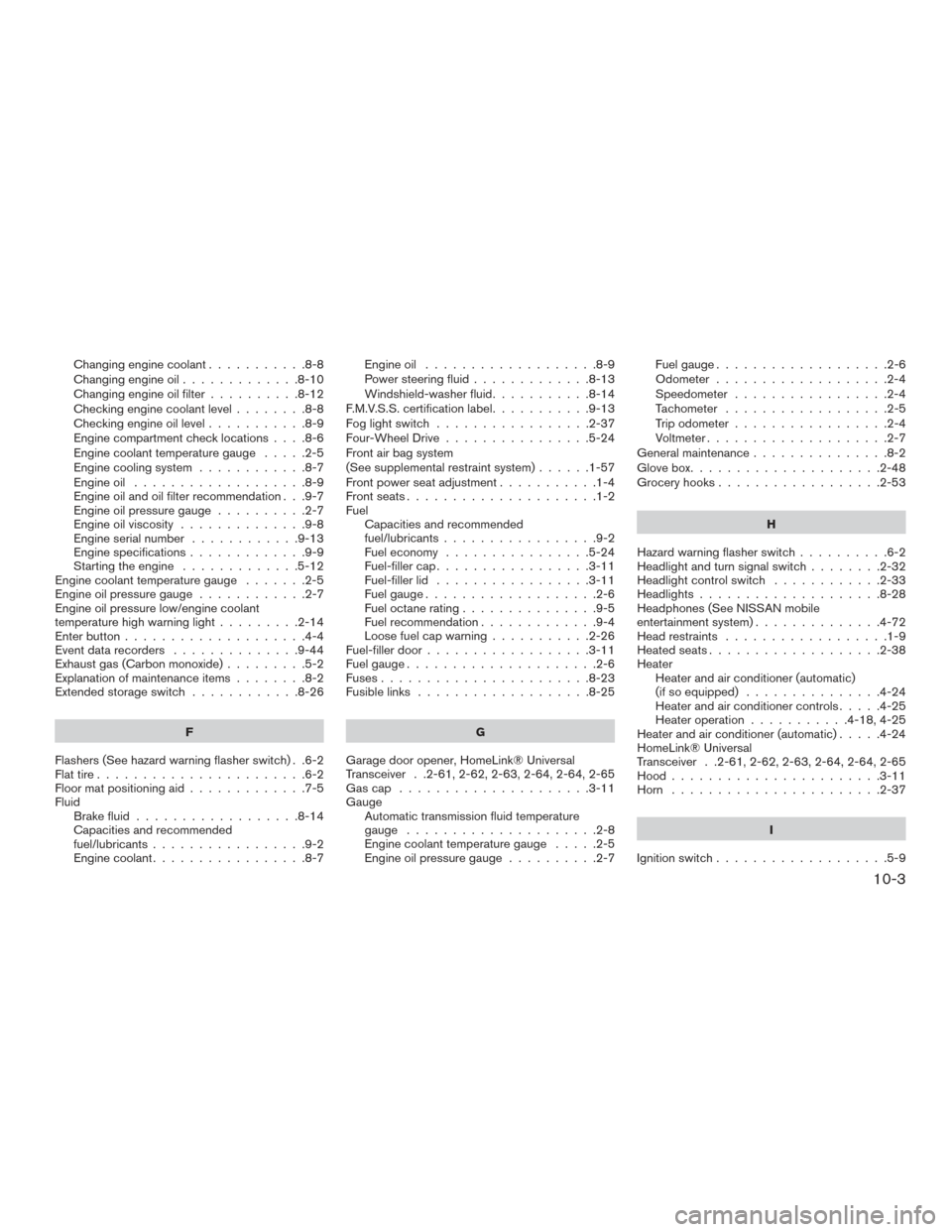
Changing engine coolant...........8-8
Changing engine oil .............8-10
Changing engine oil filter ..........8-12
Checking engine coolant level ........8-8
Checking engine oil level ...........8-9
Engine compartment check locations ....8-6
Engine coolant temperature gauge .....2-5
Engine cooling system ............8-7
Engine oil ...................8-9
Engine oil and oil filter recommendation . . .9-7
Engine oil pressure gauge ..........2-7
Engine oil viscosity ..............9-8
Engine serial number ............9-13
Engine specifications .............9-9
Starting the engine .............5-12
Engine coolant temperature gauge .......2-5
Engineoilpressuregauge............2-7
Engine oil pressure low/engine coolant
temperature high warning light .........2-14
Enterbutton....................4-4
Event data recorders ..............9-44
Exhaust gas (Carbon monoxide) .........5-2
Explanation of maintenance items ........8-2
Extendedstorageswitch ............8-26
F
Flashers (See hazard warning flasher switch) . .6-2
Flat tire .......................6-2
Floor mat positioning aid .............7-5
Fluid Brake fluid ..................8-14
Capacities and recommended
fuel/lubricants .................9-2
Engine coolant .................8-7 Engine oil
...................8-9
Power steering fluid .............8-13
Windshield-washer fluid ...........8-14
F.M.V.S.S. certification label ...........9-13
Foglightswitch .................2-37
Four-Wheel Drive ................5-24
Front air bag system
(See supplemental restraint system) ......1-57
Front power seat adjustment ...........1-4
Frontseats.....................1-2
Fuel Capacities and recommended
fuel/lubricants .................9-2
Fuel economy ................5-24
Fuel-filler cap .................3-11
Fuel-filler lid .................3-11
Fuel gauge ...................2-6
Fuel octane rating ...............9-5
Fuel recommendation .............9-4
Loose fuel cap warning ...........2-26
Fuel-filler door ..................3-11
Fuelgauge.....................2-6
Fuses.......................8-23
Fusiblelinks ...................8-25
G
Garage door opener, HomeLink® Universal
Transceiver . .2-61, 2-62, 2-63, 2-64, 2-64, 2-65
Gascap .....................3-11
Gauge Automatic transmission fluid temperature
gauge .....................2-8
Engine coolant temperature gauge .....2-5
Engine oil pressure gauge ..........2-7 Fuelgauge...................2-6
Odometer
...................2-4
Speedometer .................2-4
Tachometer ..................2-5
Trip odometer .................2-4
Voltmeter ....................2-7
General
maintenance ...............8-2
Glovebox.....................2-48
Groceryhooks..................2-53
H
Hazard warning flasher switch ..........6-2
Headlightandturnsignalswitch........2-32
Headlightcontrolswitch ............2-33
Headlights....................8-28
Headphones (See NISSAN mobile
entertainment system) ..............4-72
Head restraints ..................1-9
Heated seats ...................2-38
Heater Heater and air conditioner (automatic)
(if so equipped) ...............4-24
Heater and air conditioner controls .....4-25
Heater operation ...........4-18,4-25
Heater and air conditioner (automatic) .....4-24
HomeLink® Universal
Transceiver . .2-61, 2-62, 2-63, 2-64, 2-64, 2-65
Hood.......................3-11
Horn .......................2-37
I
Ignition switch ...................5-9
10-3
Page 453 of 457
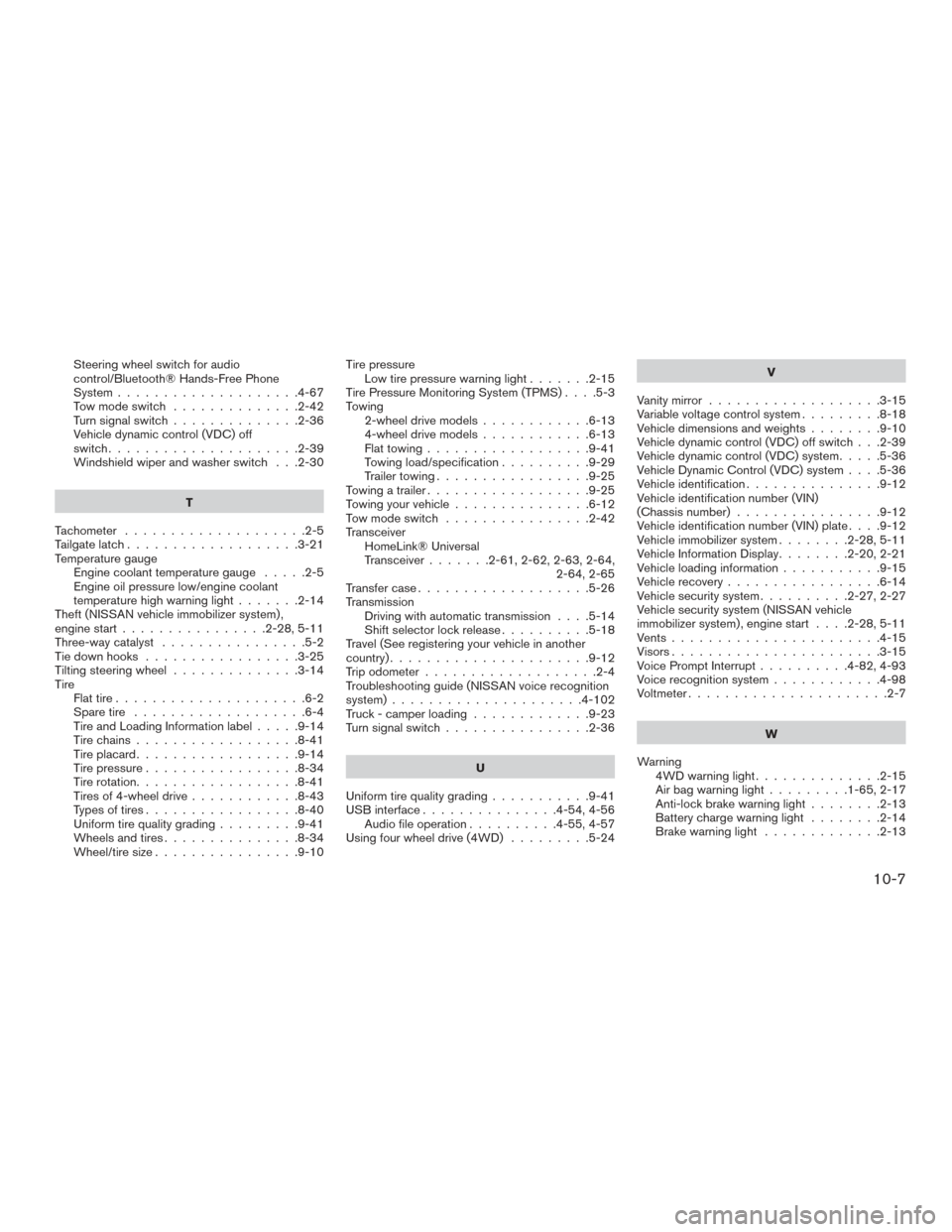
Steering wheel switch for audio
control/Bluetooth® Hands-Free Phone
System....................4-67
Tow mode switch ..............2-42
Turnsignalswitch..............2-36
Vehicle dynamic control (VDC) off
switch.....................2-39
Windshield wiper and washer switch . . .2-30
T
Tachometer ....................2-5
Tailgate latch ...................3-21
Temperature gauge Engine coolant temperature gauge .....2-5
Engine oil pressure low/engine coolant
temperature high warning light .......2-14
Theft (NISSAN vehicle immobilizer system) ,
engine start ................2-28,5-11
Three-way catalyst ................5-2
Tie down hooks .................3-25
Tilting steering wheel ..............3-14
Tire Flat tire .....................6-2
Spare tire ...................6-4
TireandLoadingInformationlabel.....9-14
Tire chains ..................8-41
Tireplacard..................9-14
Tirepressure.................8-34
Tire rotation..................8-41
Tires of 4-wheel drive ............8-43
Types of tires .................8-40
Uniform tire quality grading .........9-41
Wheels and tires ...............8-34
Wheel/tire size ................9-10 Tire pressure
Low tire pressure warning light .......2-15
Tire Pressure Monitoring System (TPMS) ....5-3
Towing 2-wheel drive models ............6-13
4-wheel drive models ............6-13
Flattowing..................9-41
Towing load/specification ..........9-29
Trailer towing .................9-25
Towing a trailer ..................9-25
Towingyourvehicle...............6-12
Tow mode switch ................2-42
Transceiver HomeLink® Universal
Transceiver .......2-61,2-62,2-63,2-64,
2-64, 2-65
Transfer case ...................5-26
Transmission Driving with automatic transmission ....5-14
Shift selector lock release ..........5-18
Travel (See registering your vehicle in another
country) ......................9-12
Trip odometer ...................2-4
Troubleshooting guide (NISSAN voice recognition
system) .....................4-102
Truck - camper loading .............9-23
Turn signal switch ................2-36
U
Uniform tire quality grading ...........9-41
USB interface ...............4-54,4-56
Audio file operation ..........4-55,4-57
Using four wheel drive (4WD) .........5-24 V
Vanity mirror ...................3-15
Variable voltage control system .........8-18
Vehicle dimensions and weights ........9-10
Vehicle dynamic control (VDC) off switch . . .2-39
Vehicle dynamic control (VDC) system .....5-36
Vehicle Dynamic Control (VDC) system .
. . .5-36
Vehicle identification ...............9-12
Vehicle identification number (VIN)
(Chassis number) ................9-12
Vehicle identification number (VIN) plate ....9-12
Vehicle immobilizer system ........2-28,5-11
Vehicle Information Display ........2-20,2-21
Vehicle loading information ...........9-15
Vehicle recovery .................6-14
Vehicle security system ..........2-27,2-27
Vehicle security system (NISSAN vehicle
immobilizer system) , engine start ....2-28,5-11
Vents.......................4-15
Visors.......................3-15
Voice Prompt Interrupt ..........4-82,4-93
Voice recognition system ............4-98
Voltmeter......................2-7
W
Warning 4WD warning light ..............2-15
Airbagwarninglight.........1-65,2-17
Anti-lock brake warning light ........2-13
Battery charge warning light ........2-14
Brake warning light .............2-13
10-7